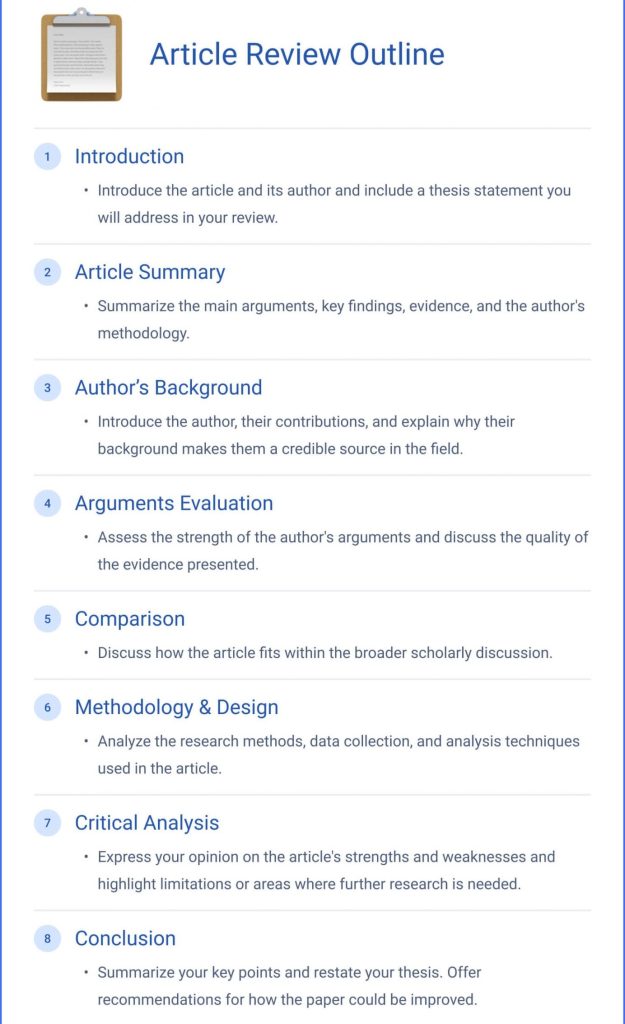
Table of Contents
Nursing article reviews are essential for staying abreast of the latest research, clinical practices, and trends within the field. But writing a compelling and informative review that goes beyond a mere summary is a skill in itself. Engaging readers, sparking insightful discussions, and ultimately influencing clinical practice requires more than just summarizing the key findings; it demands a thoughtful and insightful approach.
This article provides a comprehensive guide to crafting impactful nursing article reviews, outlining key strategies and considerations for maximizing their effectiveness.
What is an Article Review?
An article review is a critical analysis of a published scholarly article. It’s not just summarizing the article’s content; it involves evaluating its strengths, weaknesses, and overall contribution to the field of study.
Here’s a breakdown of the key components of article reviews:
1. What is it about?
- Summary: Concisely describe the article’s central argument, research question, methodology, and key findings.
- Context: Briefly explain the article’s place within the existing literature. What gap does it aim to fill? What other research does it build upon?
2. How well is it done?
- Strengths: Highlight the article’s strong points. For example:
- Is the research methodology sound?
- Is the evidence compelling and well-analyzed?
- Does the author present a clear and convincing argument?
- Does the article contribute original insights to the field?
- Weaknesses: Identify any shortcomings or limitations. For example:
- Are there any methodological flaws?
- Are the conclusions overly broad or not fully supported by the evidence?
- Does the article ignore important perspectives or research?
- Are there any biases or limitations in the author’s approach?
3. What’s the impact?
- Significance: Evaluate the article’s overall importance and contribution to the field.
- Implications: Discuss the potential practical implications of the findings and how they might influence future research.
4. What’s missing?
- Suggestions: Offer constructive feedback and suggest areas for improvement.
5. Overall Assessment:
- Conclusion: Provide a concise and objective evaluation of the article’s strengths, weaknesses, and overall merit.
Purpose of an Article Review:
- Informative: To help readers understand the article’s main points and its contribution to the field.
- Evaluative: To assess the article’s quality, validity, and potential impact.
- Critical Thinking: To encourage readers to engage with the article’s arguments and evaluate its strengths and weaknesses.

Key Points:
- Be concise: Focus on the most important aspects of the article.
- Be objective: Avoid personal opinions and bias.
- Be clear and well-organized: Use clear and concise language and structure your review logically.
- Be accurate: Ensure your summary of the article is accurate and reflects the author’s intentions.
Types of Article Reviews:
- Descriptive Review: Summarizes the article’s content without critical analysis.
- Critical Review: Provides a detailed analysis of the article’s strengths and weaknesses.
- Analytical Review: Analyzes the article’s theoretical framework, methodology, and findings.
- Comparative Review: Compares the article to other relevant research.
Understanding the purpose and structure of an article review helps you analyze and evaluate scholarly work effectively. It’s a valuable skill for academics, researchers, and anyone who needs to critically examine information.
Step-by-Step Guide to Writing Nursing Article Reviews
1. The Foundation: Choose Wisely
Before diving into the writing process, carefully select the nursing article review subject. Choosing a relevant and timely article, aligned with your area of interest or current practice, is crucial. Consider these factors:
- Relevance: Does the article address a topic relevant to your nursing practice, current research questions, or emerging trends in your specialty?
- Impact: Does the article offer potentially groundbreaking findings or challenge existing practices, warranting further discussion and analysis?
- Methodology: Is the study’s methodology sound, ensuring the reliability and validity of the results?
- Target Audience: Is the article intended for a specific audience, such as practicing nurses, educators, or researchers? Understanding your intended readers helps tailor your review accordingly.
2. The Art of Reading: Beyond Surface Level
Once you’ve chosen an article, engage with it actively, going beyond a simple reading. This involves:
- Critical Analysis: Examine the article’s purpose, methodology, strengths, limitations, and implications for practice.
- Note-Taking: Keep meticulous notes on key findings, arguments, and supporting evidence, ensuring you capture the essence of the article.
- Reflection: Consider how the article connects to your current understanding of the topic, your clinical practice, or existing research.
3. Structuring Your Review: A Roadmap to Clarity
A well-structured nursing article review facilitates reader comprehension and engagement. Use a clear and logical structure, typically following a standardized format:
- Introduction: Begin with a compelling opening, introducing the article’s topic, its relevance to nursing practice, and your overall assessment.
- Summary: Provide a succinct overview of the article’s key findings, methodology, and study design. Avoid simply paraphrasing; synthesize the information to highlight the most salient points.
- Analysis and Critique: This section is crucial for demonstrating your critical thinking and offering valuable insights. Examine the article’s strengths and limitations, considering its impact on nursing practice, potential biases, and limitations of the study.
- Implications for Practice: Discuss how the article’s findings can be translated into real-world nursing practice, highlighting potential applications and recommendations for future research.
- Conclusion: Summarize your overall assessment of the article, emphasizing its contribution to the field and its impact on nursing knowledge and practice.

4. The Language of Engagement: Crafting a Compelling Narrative
Effective writing for nursing article reviews requires a balance of clarity, precision, and engaging prose. Here are some tips:
- Active Voice: Use active voice whenever possible to make your writing more dynamic and impactful. Avoid passive constructions that can sound dull and impersonal.
- Concise Language: Be precise and concise in your writing, avoiding unnecessary jargon or overly complex sentence structures.
- Specificity: Use specific examples and data points from the article to support your claims and make your analysis more concrete.
- Balance of Objectivity and Subjectivity: While maintaining objectivity, incorporate your own perspectives and interpretations to create a more engaging and thought-provoking review.
5. Beyond the Words: Enriching Your Review
Enhance the impact of your nursing article review by utilizing various strategies:
- Visuals: Incorporate relevant figures, tables, or graphs from the original article to illustrate key findings and enhance reader understanding.
- Quotes: Use relevant quotes from the article to support your analysis and provide context for your interpretation.
- Connections: Draw connections between the article’s findings and current nursing practice, highlighting potential implications and areas for further exploration.
- Call to Action: Conclude your review with a clear call to action, encouraging readers to reflect on the article’s findings, engage in discussion, or implement changes in their practice.
6. The Power of Peer Review: Seeking Feedback
Before submitting your nursing article review, have it reviewed by colleagues or mentors. Feedback from peers can help identify areas for improvement and ensure clarity, accuracy, and objectivity.
7. Disseminating Your Review: Reaching Your Audience
Publish your nursing article review in a relevant journal, online platform, or professional newsletter. Consider sharing it with colleagues, mentors, or online forums to stimulate discussion and further dissemination of knowledge.
8. Examples of Engaging Nursing Article Reviews
To gain inspiration and understand the key elements of impactful nursing article reviews, explore reputable journals and online platforms for examples of well-written reviews. Observe how authors:
- Articulate the article’s significance: Clearly explain why the topic is important to nursing practice.
- Present a critical analysis: Offer a balanced and insightful evaluation of the article’s strengths and limitations.
- Connect findings to practice: Discuss how the research can be applied to real-world settings.
- Foster engagement: Use clear, engaging language, visuals, and calls to action to spark discussion and further exploration.
9. Continual Learning and Development
Engaging with nursing article reviews is an ongoing process. Continuously evaluate your own writing practices, seek feedback, and stay informed about the latest trends in nursing research.
10. The Impact of Nursing Article Reviews: Fostering a Culture of Knowledge
Well-written nursing article reviews play a critical role in advancing nursing practice, fostering a culture of evidence-based care, and promoting professional growth. By critically analyzing, interpreting, and disseminating research findings, nurses contribute to the evolution of their field and ensure the highest quality of care for patients.
Common Mistakes in Nursing Article Reviews & How to Avoid Them
Writing nursing article reviews is an essential skill for nurses to stay updated with the latest research and best practices. However, common mistakes can weaken the review’s impact and clarity. Here are some pitfalls to avoid:
1. Lack of Focus & Structure:
- Mistake: Reviews lack a clear purpose or structure, jumping between unrelated points.
- Solution: Define the review’s aim upfront. Structure it logically, using headings and subheadings to guide the reader.
2. Inadequate Summarization:
- Mistake: Reviews only provide a superficial overview of the article, failing to capture its key findings.
- Solution: Accurately summarize the article’s methodology, results, and conclusions. Use concise language and avoid unnecessary details.
3. Lack of Critical Analysis:
- Mistake: Reviews merely restate the article’s information without offering critical analysis or insights.
- Solution: Analyze the article’s strengths and limitations. Discuss its implications for nursing practice and future research.
4. Inadequate Evidence & Support:
- Mistake: Reviews make broad claims without providing evidence or supporting data from the article.
- Solution: Use quotes and data from the article to support your claims. Use clear and specific examples.
5. Poor Writing Style:
- Mistake: Reviews are poorly written, with grammatical errors, unclear language, and jargon.
- Solution: Write clearly and concisely. Use active voice and avoid unnecessary technical terms. Proofread carefully before submitting the nursing article review.
6. Bias & Lack of Objectivity:
- Mistake: Reviews reflect personal opinions or biases without acknowledging them.
- Solution: Maintain objectivity and present a balanced perspective. Acknowledge potential biases and limitations of the article.
7. Lack of Relevance to Nursing:
- Mistake: Nursing article reviews fail to connect the article’s findings to nursing practice or relevant issues.
- Solution: Explain how the article’s findings are relevant to nurses and nursing practice. Consider implications for patient care, education, or policy.
8. Neglecting to Cite Sources:
- Mistake: Reviews lack proper citations, leading to plagiarism and credibility issues.
- Solution: Cite all sources correctly using the appropriate referencing style.
By avoiding these common mistakes, you can write impactful nursing article reviews that effectively communicate the article’s findings and their relevance to nursing practice. Remember, your nursing article review is a valuable tool for knowledge sharing and professional development.

Sample Nursing Article Review
Review of: “Impact of Early Mobility on Postoperative Outcomes in Hip Fracture Patients: A Randomized Controlled Trial” by Smith et al. (2023)
This randomized controlled trial by Smith et al. (2023) investigates the impact of early mobility on postoperative outcomes in hip fracture patients. The study, published in the Journal of Orthopaedic & Sports Physical Therapy, aimed to determine if early mobilization, initiated within 24 hours of surgery, improves functional outcomes and reduces length of stay compared to standard care.
Methodology and Findings:
The study enrolled 100 patients with hip fractures, randomly assigning them to either early mobilization (n=50) or standard care (n=50). Early mobilization involved initiating out-of-bed activities within 24 hours of surgery, with a structured exercise program. The primary outcome measures included functional independence (measured by the Barthel Index) and length of hospital stay. The researchers found that the early mobilization group demonstrated significantly improved functional independence at 6 weeks post-surgery compared to the standard care group. Additionally, the early mobilization group had a significantly shorter length of stay.
Strengths & Limitations:
The study’s strengths include its rigorous methodology, utilizing a randomized controlled design and a large sample size. The clear definition of intervention protocols and objective outcome measures contribute to the study’s robustness. However, the study’s limitations include the lack of follow-up beyond 6 weeks, potentially overlooking long-term outcomes. Additionally, the study’s focus on a specific patient population (hip fracture) may limit generalizability to other orthopedic conditions.
Implications for Nursing Practice:
This study provides strong evidence supporting the benefits of early mobility for hip fracture patients. Nurses can play a crucial role in implementing and promoting early mobilization protocols. The findings underscore the importance of patient education, pain management strategies, and collaboration with physical therapists to facilitate safe and effective early mobilization.
Recommendations for Future Research:
Future research should explore the long-term effects of early mobility on hip fracture patients, including functional recovery and quality of life. Additionally, investigating the effectiveness of early mobilization in other orthopedic populations would contribute valuable insights to nursing practice.
Conclusion:
Smith et al.’s (2023) study provides valuable evidence supporting the implementation of early mobilization protocols for hip fracture patients. This research highlights the significant impact of nursing interventions on postoperative outcomes, emphasizing the importance of proactive and evidence-based care. Nurses can utilize this research to advocate for and facilitate early mobility practices, ultimately contributing to improved patient outcomes and reduced healthcare costs.
Frequently Asked Questions about Nursing Article Reviews
1. What are nursing article reviews?
Nursing article reviews are critical evaluations of published research articles related to nursing practice, education, or research. They assess the study’s methodology, findings, and implications for nursing practice.
2. Why are nursing article reviews important?
Nursing article reviews are essential for staying up-to-date with current research, evaluating the validity of evidence-based practice, and informing clinical decision-making.
3. What are the key elements of a good nursing article review?
A good nursing article review should include:
- A clear and concise summary of the research question, methods, results, and conclusions.
- A critical appraisal of the study’s methodology, including its strengths and limitations.
- An assessment of the study’s implications for nursing practice, education, or research.
- A discussion of the study’s relevance to current nursing knowledge and practice.
4. How do I write a nursing article review?
Writing a strong nursing article review involves:
- Understanding the article: Carefully read and analyze the article, focusing on its purpose, methodology, results, and conclusions.
- Evaluating the methodology: Assess the study’s design, sample size, data collection methods, and statistical analysis.
- Synthesizing findings: Summarize the key findings of the study in a clear and concise manner.
- Drawing conclusions: Discuss the implications of the study for nursing practice, education, or research.
- Maintaining objectivity: Present your review in a neutral and objective manner, avoiding personal opinions or biases.
5. Where can I find examples of nursing article reviews?
You can find examples of nursing article reviews in various academic journals, online databases, and nursing textbooks. Look for articles that focus on reviewing research in the field of nursing.
6. How can I improve my nursing article review writing skills?
Practice is key! Start by reviewing articles on topics that interest you. Seek feedback from colleagues, mentors, or instructors. Consider taking courses or workshops specifically designed to enhance your nursing article review writing skills.
Writing effective nursing article reviews is a valuable skill that can contribute to your professional development and advancement in the nursing field.

The Bottom Line
Writing effective nursing article reviews is a valuable skill that allows nurses to critically engage with research, contribute to the body of knowledge, and improve patient outcomes. By following the strategies outlined in this guide, you can create impactful nursing article reviews that captivate readers, spark dialogue, and ultimately shape the future of nursing practice. Remember, the goal is not just to summarize the article but to analyze it, interpret its implications, and connect it to the world of nursing in a way that informs, inspires, and fosters a culture of continuous learning and improvement.
Get Professional Help with Writing Nursing Article Reviews
Crafting compelling nursing article reviews can still be challenging even when following the above guidelines. But, you can easily avoid the stress with professional help from PhD Nurse Writer. We can assist you in crafting authentic and engaging nursing article reviews, research papers, essays, case studies and dissertations. Our service covers topic suggestion, paper writing, proofreading, editing, formatting and plagiarism removal.





